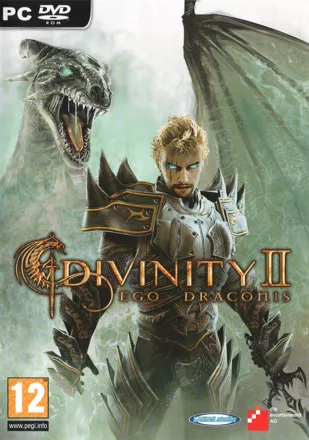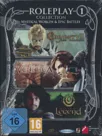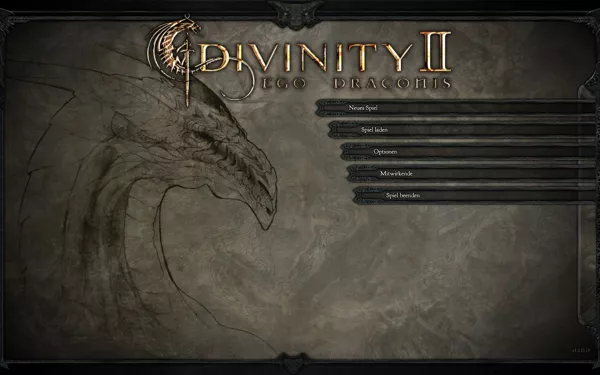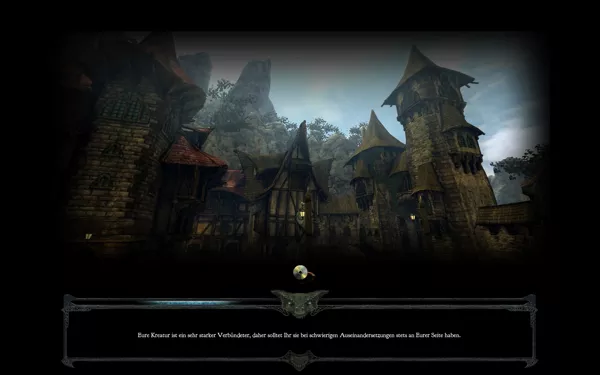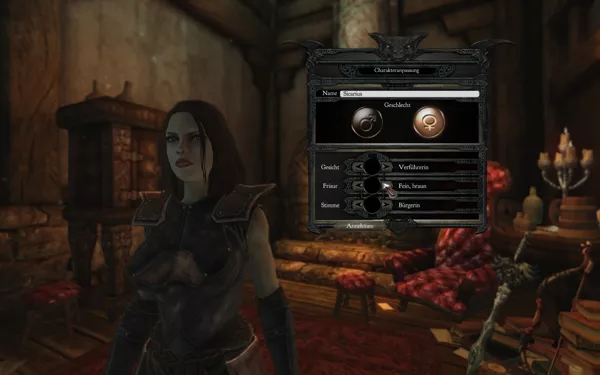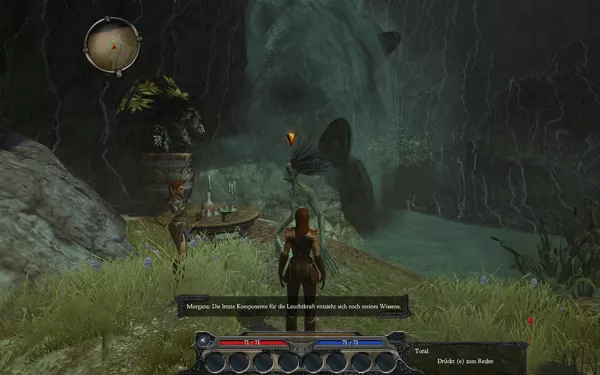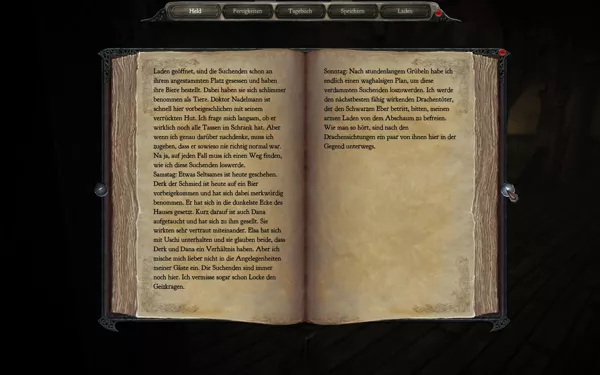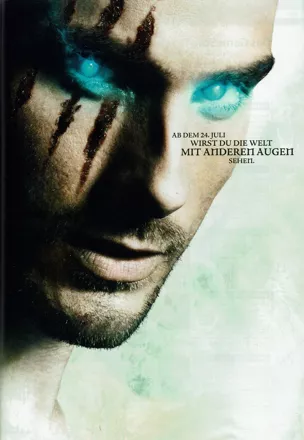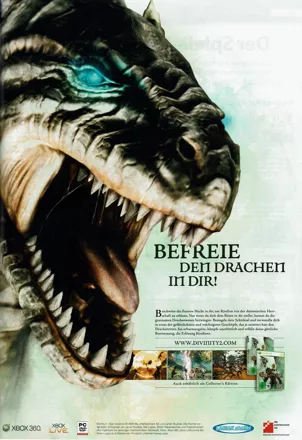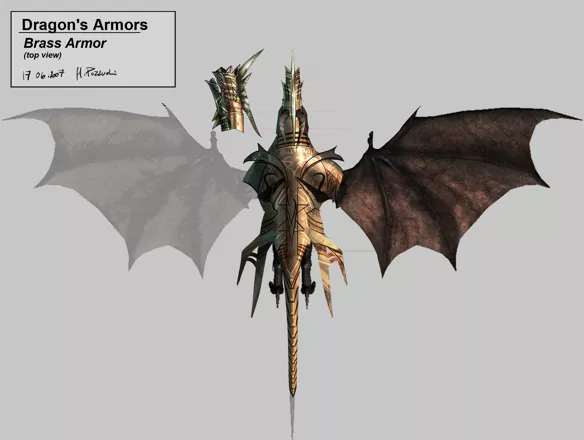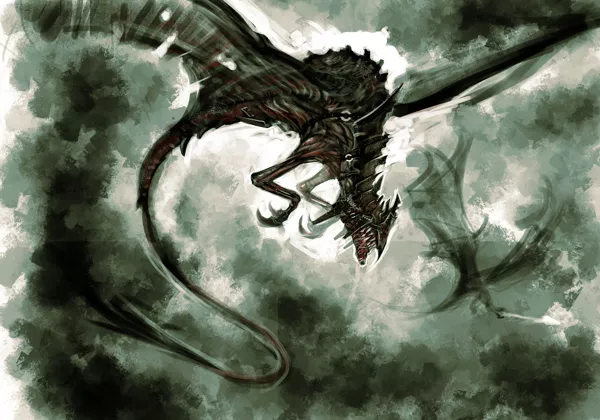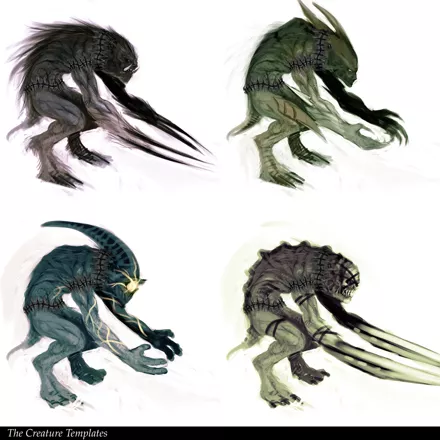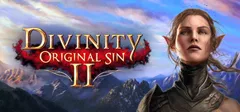Divinity II: Ego Draconis
Description official descriptions
A moment of weakness doomed the Divine called Lucian. Instead of putting an end to all the misery by killing the child of the God of Lies, he showed mercy, let it live and even put it on himself to raise him. A most fatal decision, as it made it possible for the Black Ring to introduce Ygerna, daughter of Kalin, a necromancer in the ranks of the Black Ring, into the life of Damian as the boy was called. Bound to her through his love, Ygerna released the powerful magic slumbering inside of Damian. When Lucian learned of what Ygerna had done, he had no choice than to execute her. Being witness to the execution, Damian bound his soul to Ygerna and by doing so marked the return of the Damned. Damian swore revenge for the death of Ygerna but his rage and anger were also his doom. In the battle between the Black Ring and the Divine Paladins, Lucian managed to lure Damian into the Fissure-Temple and ban him into the dark world of Nemesis.
But even the Nemesis couldn't contain Damian's rage and when he suddenly emerged from the dimension, the armies of Rivellon weren't able to withstand his force. The following war changed the land. Once mighty mountains were reduced to burned earth. Green meadows had to make room for impassable, cragged landscapes. Not all hope was lost though: when the Divine allied himself with the Dragon Knights, the last advocates of Dragon-Magic in the demon-tainted lands of Rivellon, the final battle against Damian ensued. Ironic, that in the end all was lost because of the betrayal of one of the Dragon Knights who back-stabbed the Divine. But Damian got his revenge and both sides retreated from the battlefield. Since then, half-a-century has passed and most of the people have already forgotten what had happened that day and already think of Damian as an urban legend. Another fatal mistake...
Divinity II: Ego Draconis is an action role-playing game and the first 3D installment in the Divinity series. The player takes on the role of a Dragon Hunter from a third-person-perspective. The protagonist is soon involuntarily converted into a Dragon Knight, which, much later in the game, gives him the ability to transform himself into a dragon once he uncovers the means to control his power. As a dragon, he has access to different abilities, shares half of his experience with his human form and can also fly over the lands and use his fire spells against enemies. In human form, the player has to decide after the tutorial if he wants to be a knight, ranger or sorcerer - although he is still free to level his five skills and dozens of talents as he pleases without being limited to fit the class he began the game with. The talents are divided into five categories: priest (can summon ghosts to aid him), sorcerer, knight, ranger and dragon slayer (general talents). One of these general talents is mind reading. For the price of some experience points, the player can try to read the minds of every NPC in the world giving the player access to new information, uncovering secrets and even unlocking alternate ways to finish some of the vast array of side-quests available in Rivellon.
As in most role-playing games, points for skills and talents are gained at a level-up, and the experience points are gained through fulfilling quests and killing monsters in real-time combat, which can be paused to issue commands like activating talents or drinking a potion. The means to do so, meaning weapons, armor and other useful items, are also obtained by killing monsters, completing quests, using the vendors or simply by opening or destroying all the barrels, crates and chests scattered around the world. At the completion of each quest, the player gets both gold and experience points and can choose one additional item as a reward from a list. This also includes additional experience points and gold.
Besides the dragon form, the player also gets his very own Dragon Tower during the course of the game. Thanks to the Dragon Stone, the player can teleport himself to his home at any time. Part of the Dragon Tower is a chest in which the player can store important items, a waypoint shrine allowing him to teleport to any other shrine he already discovered, an illusionist allowing the player to change his appearance at any time and a bunch of collectors. These collectors can be sent out into the world to collect resources (plants and such) for the player, but are as vulnerable to attacks as every other NPC. To increase their chance of survival, the player can train his minions, increase their armor, and heal them if they are wounded. Of course, the player can also use the NPCs in his tower to do the same for himself. In addition, there's an alchemist available who, provided the player brings him the needed recipe and resources, creates potions, and a necromancer who can create a creature companion for the player. To do so, he needs body parts (head, torso, arms and legs) that the player finds mostly in dungeons on dead NPCs or after killing a powerful monster.
Spellings
- Divinity 2. Кровь драконов - Russian spelling
- 神諭2 - Traditional Chinese spelling
Groups +
- Console Generation Exclusives: Xbox 360
- Diablo variants
- Divinity series
- Fantasy creatures: Dragons
- Fantasy creatures: Goblins
- Fantasy creatures: Trolls
- Gameplay feature: Dragon flying / riding
- Middleware: Gamebryo / Lightspeed / NetImmerse
- Middleware: Kynapse
- Middleware: Scaleform GFx SDK
- Middleware: SpeedTree
- Physics Engine: PhysX
- Protagonist: Female (option)
- Protagonist: Visually customizable character
- Software Pyramide releases
- Sound Engine: Wwise
Screenshots
Promos
Videos
Add Trailer or Gameplay Video +1 point
See any errors or missing info for this game?
You can submit a correction, contribute trivia, add to a game group, add a related site or alternate title.
Credits (Windows version)
327 People (255 developers, 72 thanks) · View all
| Director | |
| Lead Producer | |
| Art Director | |
| Lead Artist | |
| Lead Animator | |
| Lead Engine Programmer | |
| Lead Gameplay Programmer | |
| Lead Designer | |
| Lead Writer | |
| Lead QA | |
| Lead Audio | |
| Game Production | |
| Engine Programming | |
| Gameplay Programming | |
| Flash Programming | |
| Concept Art | |
| Enviornment Art | |
| [ full credits ] | |
Reviews
Critics
Average score: 72% (based on 43 ratings)
Players
Average score: 3.8 out of 5 (based on 15 ratings with 2 reviews)
Draco sum, sed humani nil a me alienum puto!
The Good
Ego Draconis is (despite the number) the third installment in the Divinity series, which included the fantastic Divine Divinity and the imperfect, yet very interesting Beyond Divinity. I was pleased to discover that the transition to 3D and "social pressure" that must have been applied to developers, urging them to focus on flash instead of substance, has not damaged the soul of the series. Ego Draconis is much like its predecessors, which means that it is a sweet, heart-warming game with plenty of creativity and attention to detail.
Though the tutorial takes place in a suspiciously confined area, fear not: once you get past the initial training, you'll be thrown into a fairly vast location you'll be able to explore at your own pace. There is no continuous open world in the sense of Morrowind, but each act takes place in its own "mini world" complete with non-linear exploration possibilities, secrets and sub-quests. The game cannot be compared in size to either Divine Divinity or any modern 3D open-world game, but it sort of walks the middle ground between the expansive Elder Scrolls-style design and the ever-decreasing worlds of Bioware.
The important thing is that this world, small or big, is beautifully designed. There are breathtaking views and fabulous contraptions, a sense of grandeur both in outdoor and indoor locations. But that was achieved by many other games as well. What I particularly liked about Ego Draconis is how each location was clearly hand-made. Copy-pasting has unfortunately always been a prevalent trend in game design, and the developers of Ego Draconis did their best to avoid it at all costs. Each place has its own personality, and no two dungeons are alike. Speaking of those, they have certainly been reduced in size compared to the previous games, but instead have more detail and even a few nice puzzles thrown in.
In general, the world of Ego Draconis is not empty, and the game has been designed in such a way that it constantly encourages exploration and attention. You can rush through each area, but you'll miss a lot of optional content that way. By not checking every nook and cranny in every room you might not notice some interesting information or cool items. There are secrets everywhere, all sorts of locked chests and other stuff that raises your curiosity. I call a gameplay system "rewarding" when it urges you to think outside of the box and come up with creative solutions instead of just mechanically do whatever the game tells you to.
You can clearly see how valiantly Ego Draconis tries to combat simplification and excessive hand-holding. There are no "magic arrows" or even quest markers! The journal keeps track of everything you do, but you'll have to study the environment on your own and remember yourself where is what. Transportation is also done perfectly: there are waypoints that will conveniently teleport you around, but you'll have to discover them first, which means that on-foot exploration is necessary at all times. And even though the world is not truly open, there is still plenty of ground to cover, and the addition of physical abilities such as jumping and swimming is always welcome.
The game also offers a fair amount of side quests, some of which are very interesting. There are actually very few generic fetch quests, and many require you to think hard before you come up with a solution. Many quests have branching outcomes that depend on your decisions, and the choice is often anything but easy. Sometimes you'll have to choose sides, and that involves more than just automatized faction loyalty or a black-white moral system. I liked how the game put those choices into side quests and tried to focus them on personal affairs. Few games would offer you the challenge of correctly handling a situation involving marital fidelity and its consequences.
In short, Ego Draconis is a "tasty" RPG, meaning that it gives you plenty of varied material to chew on, and it has that comfortable pace that I've always associated with the classic Ultima style: neither too abstract (like in Elder Scrolls), nor too precipitated (like in modern Bioware games). Sure, Ego Draconis is neither as expansive as the former nor as cinematic as the latter, but sometimes the golden mean is the way to go, and this game represents the best of that tendency.
It is also a challenging game, requiring you to actually plan ahead and think hard before you invest those hard-earned experience points. It shares the character-building strengths with its predecessors, offering free-form customization and plenty of skills to choose from, each with its own levels of proficiency, just like in Diablo II, which was an obvious inspiration for that gameplay mechanic. Combat is a bit simplistic, but fun nevertheless. There are new interesting skills such as mind-reading, which often leads to unexpected results or good rewards. The addictiveness of randomized items is back, with plenty of weapons and equipment to try out.
In addition, Ego Draconis also offers some cool gameplay elements of its own invention. The most notable one is, of course, the ability to turn into a dragon. You'll have to wait a long time before you get hold of that, and even then the feature is quite restricted, but it is indeed awesome to soar through skies, setting huge enemy fortresses on fire. You can even equip your dragon with claw weapons and armor, and I think a sight of the fearsome reptile clad in leather leggings and a cute cap is bound to make you smile. Late in the game you also acquire your own tower, where you have access to more cool features - a necromancer that builds summonable creatures for you (which you can outfit with dead body parts!), an alchemy garden harboring an entire complex system of potion-brewing and alike, a blacksmith that would customize your weapons, and so on.
The main plot in the game is quite predictable for the most part, but the exotic characters and the wealth of side quests make up for that. It's the small details that matter, sometimes buried deep within the game's intricate sub-quest system, there for you to discover. I was, for once, delighted to meet a skeleton during a journey to an optional location, with whom I was able to engage in a provocative philosophical discussion and eventually made him disappear by convincing him that he couldn't possibly exist. And who can forget that pig-lover of a farmer who sent me on a dramatic quest to rescue his precious sus domesticus by whispering "Rosebud" into his ear?..
The Bad
As much as they tried to reduce the loss of material, in some aspects it unfortunately became clear that even this game underwent simplification and "streamlining". For once, there is significantly less physical interactivity than in both its predecessors. You can't just pick up everything you see and drag things around any more, which makes the environment less busy and less immersive. Yes, the two predecessors were 2D, but physical interactivity has been with 3D games since the incomparable Ultima Underworld. I guess I just expected a bit too much from Larian, but that only means that I really value their work.
There is also less loot for some reason. Enemies rarely leave anything behind, and while there is plenty of treasure, at some point it became irritating to whack down hordes of bandits without getting even some basic weapons in return. You'll need to hunt down enemies, though, since there are no huge "battlefield" areas any more, and the world itself is smaller than in Divine Divinity, while the enemies are still finite. I also think that there could have been more populated places. There is a village in the beginning and a few tiny settlements afterwards, but no real urban areas. The expansion corrects that somewhat, but I still felt it was too little.
The Bottom Line
Ego Draconis may not be the second coming, but it is one of the few modern RPGs put together with soul and true dedication rather than calculating, market-oriented attitude. It's not about newest special effects or ultra-cinematic cutscenes: it's about venerable, classic RPG traditions handed to you with humor and heart and just a little bit of originality to spice things up.
Windows · by Unicorn Lynx (181621) · 2014
Somewhat unusual, but in a good way
The Good
Ok, I'll admit that I didn't really get into this game at first. It took quite a bit of getting used to. However, it grew on me as I went along. It probably didn't help that I was playing Dragon Age: Origins at the same time, which outshines this game, but even so, I did end up getting hooked on the game.
The game is a pretty standard RPG, but focuses on a single main character without party members. At first, that distracted me from the game as it made things that should be easy more of a pain at the beginning of the game. But, as you progress, you do gain the ability to summon a "homemade" necromantic creature that you can continually upgrade with new body parts (head, torso, arms, and legs). Although weak to begin with, it does become a very valuable "party member." You can also summon temporary creatures (ghosts, demons, etc) to help out and they can make a real difference in the outcome of many fights. So, even though you don't have a real party, you can create a temporary one whenever you want, even charming the enemy to help out. I've decided that I think this is a good thing for the game, but it was hard won... I prefer having a party to help out.
The story is pretty much what you would expect from a medieval RPG. There is some limited lore in books that helps progress the story and a lot of side quests that are almost required just to level up enough to handle the fights. Nothing too unique here and not really spectacular either. That said, the story is good and there are some interesting plot twists to help keep the story flowing smoothly.
One somewhat unique aspect of the game is the ability to read the minds of anyone you meet. Doing so can get you better prices at vendors, extra skill or stat points, extra items, etc. The price of doing so is experience, which is a good way to handle it in one sense, but ends up making it become just a "Meet new character, Save game, Mindread character, If character's mindread gives something useful continue playing otherwise reload and skip mindread." That's not really a good thing to happen to any feature of a game. Even so, the mindreading is intriguing and you can hear some unexpected things from some characters, such as how the blacksmith lost the key to his basement while in the stables with his wife and how he thought it was worth it. So it definitely adds to the interest of the story and characters in the game.
The conversations you have with various characters can be engaging and sometimes funny. From the doctor who wears a weird metal hat that blocks mindreading, to ZixZax, the Almost Wise who calls you "Soon To Be Wise," you'll find some very unique characters to talk to.
Once you can turn into a dragon, the game really gets good as fighting while a dragon is actually quite enjoyable and controls are really well done. The only downside is that you can't see enemies that are on the ground while in dragon form. That means that you can't swoop down and clear the road, then land and run down it. If you want to run down the road, you'll have to kill everything on it while on foot. I suppose that keeps the game from becoming too easy, but it was a bit of a let down... I would have loved to swoop down on unsuspecting goblins and fry them up!
When you have your Battle Tower, you can send some guys out to hunt for more herbs and ores so you don't have to find everything yourself. That can make it easier to keep your potion or enchantment stock full and to find those rare ingredients. This is free to do, but if you want better results, you need to pay for armor and weapon upgrades (and healing) for them. You can't just give them armor you find... you'll have to actually pay for each person.
Another useful ability once you have the Battle Tower is that you can send items you loot/collect to the Battle Tower without traveling there, making it difficult to run out of space. You can also choose to teleport back to it at any time and then return to where you were, making it very easy to upgrade, sell, or buy things even if you are way down deep in a cave.
The Bad
What has to be the most annoying thing for me in the game is how the characters move when they talk to you. I have no idea what they were thinking when they animated the characters in this game. For some reason, every single characters acts as though they have no spine when talking to you. Their heads bob around like crazy and their arms are constantly moving. Very unrealistic and definitely distracts from the game. Not really a game killer, but definitely knocks it down a few pegs compared to most other games with regards to character animation.
Experience quickly becomes a problem in this game and makes the beginning of the game really painful, which is why it took me time to start really liking it. If you don't do almost every single side quest, you won't level up enough to move on to the next area. At least, not unless you max out Wisdom (bonus experience). I normally do most side quests, but not always in order. That quickly became a problem because I'd try going off to some area where a side quest was and everything would be 2-3 levels higher than me and in groups of 3-4 that you can't lure away individually. I'd have to look around to find that one area that was a little lower level and work that area first until I leveled up enough. The problem being that the maps aren't really all that linear in how the enemy levels are set up. It quickly became a back and forth battle as I try one part of the map, then back away and try another and keep repeating until I find what I can handle. It really made the beginning of the game a pain. I don't mind a challenge, but this wasn't a challenge so much as a real annoyance.
Trying to look around for areas that you can handle becomes more challenging because some enemies in the groups are extremely strong and you usually don't know that until you're in the middle and getting your butt kicked, it became almost unbearable. For example, you can't really target enemies while outside of range to see if anyone is a stronger character (a captain, epic, etc) and those usually look almost the same as the others around them. Then, when you get into the battle thinking you can do alright, they hit you for a third of your total health with each hit... not counting the damage you are taking from the others in the group. This is definitely a game where you want to save frequently and in multiple spots (especially because in some areas, once you enter, you can't leave and if the enemies are too much for you to handle, you're stuck).
If they had added more side quests, it might not have been such a big deal, but there seems to be just barely enough as you go along, which makes the side quests no longer optional and you might as well consider them to be main quests.
The pause ability that should let you work on tactics doesn't allow you to really do much of anything, making it almost pointless. I end up almost never touching it, though a real pause feature similar to most other "realtime w/ pause" RPG games would greatly improve my experience.
For the first large part of the game, you're just a human and you have absolutely no storage, yet you're expected to gather a ton of herbs, ores, and scrolls explaining how to make potions or enchantments as you go along. Your bag is a decent size, but it very quickly fills up with all those ingredients that you can't really make much use of until you get your Battle Tower (many hours into the game). There is a "hidden" herbalist right at the start and an enchanter that you can't get to much before you go to take the Battle Tower due to where he's located with higher level enemies around him that can make use of the herbs and ores, but only certain ones... you'll still have a huge number of them sitting in your bags taking up space. They do stack to 50 per bag slot, but there are so many kinds that it's just too much without some way to store them. Once you have the Battle Tower, you do have a storage chest that has 400 slots, which is way more than you can hold (even with endurance skill upgrades that increase bag space... though there are more important skills that make spending points on bag space uncomfortable). So if you can survive long enough without storage until then, you'll be fine afterwards. It is just a pain until then.
Controls and targeting aren't really set up well... unless you lock onto a target by pressing the target lock key, it's hard to keep yourself facing the enemy you're fighting while in melee. Your character is set up to do jumps and rolls to help make it hard on the enemy to hit you. Unfortunately, this also means your characters tends to jump around a bit while just attacking and you end up facing the wrong way and missing. The downside of target lock is that you have very little control of who you attack without cycling through targets similar to how you would in a flight combat game. Although cycling works in flight combat, it doesn't work in melee combat. More often than not, I skip targeting and just do my best to keep facing the enemy.
The Bottom Line
Well, that sure seems to make it look like there is more bad than good about the game, but that's not exactly true. The game is a good game and enjoyable to play once you get past the issues I mentioned. Most of those issues are only really a problem at the beginning of the game and once you get your Battle Tower they either disappear altogether or are more manageable.
This is one of those games that are hard to rate because there is a definite enjoyment curve (low to start, but high after you're 15+ levels into it). I think it's worth playing and I really enjoy it, but if you're not someone who can work through a poorly handled beginning of the game, you may not make it far enough to start really enjoying it.
If you want to play just one RPG this year on PC, get Dragon Age as it's a much more polished game. However, if you want to play multiple RPGs this year and are willing to have a slow, painful start to the game, I'd recommend trying this as well. Where Dragon Age is really an interactive RPG, this one is more of a hack and slash RPG. It really is a better game that it sounds from this review, but it's hard to really describe why that is.
Windows · by Riamus (8446) · 2009
Trivia
References
Various developer names can be found in the game:
- The gate guards to the village of Broken Valley are called Joris and Paul after designers Joris Vervoort and Paul van Eekelen
- There's also a herb in the game called "farhangite" after lead designer Farhang Namdar. Its description reads: "What you think looks like a useless lump does happen to have some redeeming qualities. Among other things, this plant is renowned for getting rid of nasty embarrassing rashes."
Analytics
Related Sites +
-
CDV - Divinity II
US Publisher's product page for the game -
Divinity II
the official website -
Kirill Pokrovsky's Site
Music composer's site, offering the game's soundtrack as a free download. -
X360A achievement guide
X360A's achievement guide for Divinity II: Ego Draconis.
Identifiers +
Contribute
Are you familiar with this game? Help document and preserve this entry in video game history! If your contribution is approved, you will earn points and be credited as a contributor.
Contributors to this Entry
Game added by Sicarius.
Xbox 360 added by jaXen.
Additional contributors: Jeanne, vedder, Zeppin, Klaster_1, Paulus18950, Starbuck the Third, Cavalary, Plok.
Game added August 4, 2009. Last modified February 20, 2025.


